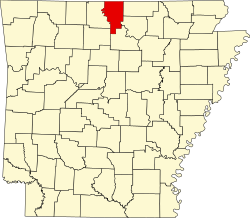Mountain Home, Arkansas | |
|---|---|
 Location of Mountain Home in Baxter County, Arkansas. | |
| Coordinates: 36°20′10″N92°22′56″W / 36.33611°N 92.38222°W | |
| Country | United States |
| State | Arkansas |
| County | Baxter |
| Area | |
| 11.97 sq mi (30.99 km2) | |
| • Land | 11.97 sq mi (30.99 km2) |
| • Water | 0 sq mi (0.00 km2) |
| Elevation | 814 ft (248 m) |
| Population (2020) | |
| 12,825 | |
• Estimate (2024) | 13,348 |
| • Density | 1,071.8/sq mi (413.81/km2) |
| • Metro | 41,307 |
| Demonym | Mountain Homie |
| Time zone | UTC-6 (Central (CST)) |
| • Summer (DST) | UTC-5 (CDT) |
| ZIP codes | 72653-72654 |
| Area code | 870 |
| FIPS code | 05-47390 |
| GNIS feature ID | 2404330 [2] |
| Website | cityofmountainhome |
Mountain Home is a city in and the county seat of Baxter County, Arkansas, United States, [3] in the southern Ozark Mountains near the northern state border with Missouri. As of the 2010 census, the city had a population of 12,448. [4] A total of 41,307 persons lived within the city and micropolitan area combined, which encompasses the majority of Baxter County.
Contents
- History
- Founding and early days
- The courthouse
- Civil War
- Post Civil War through the 1920s
- The Great Depression
- The New Deal
- Geography
- Climate
- Transportation
- Media
- Radio
- Television
- Theater
- Demographics
- 2020 census
- 2010 census
- 2000 census
- Education
- ASU – Mountain Home
- Mountain Home school district
- Notable people
- References
- External links



